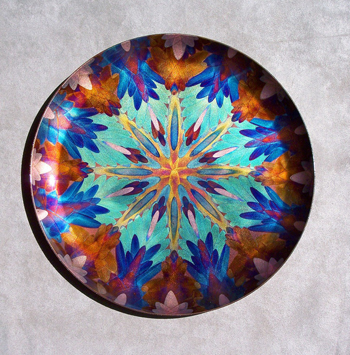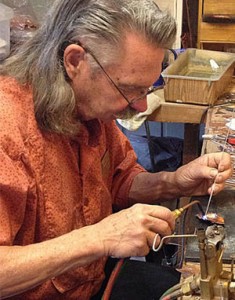Mastering the Art of Flame Painting
 Flame Painting by Skip and Racheal Mathews.
Flame Painting by Skip and Racheal Mathews. Photograph courtesy of Skip Mathews.
Skip Mathews made a decision during his college studies at the University of Arizona, Tucson, that shaped his artistic journey as a coppersmith for the last 50 years.
“I had the choice in college of being a potter or a metalsmith," he says. "Luckily, I didn’t have the money to be a potter."
“When I left the University, I started with a candle company, making copper clad candles. Then, I progressed on with the copper and began doing jewelry,” he says.
Soon, he had a realization that would change his artistic career.
“Whenever I would solder, there would always be these colors around these solder marks," he says. "Fifteen years later, I finally realized it was the reduction part of my torch. I promised myself for the next ten years I would make nothing but butterflies to perfect the process."
Along the way, he made another discovery.
“In the beginning, I had no idea that patterns were even possible,” he says. “When I saw I was able to create patterns -- that just sort of opened up all sorts of things. Initially I thought I could only do one color.”
Six years into his experimentation process, he figured out how to create patterns in specific colors on the copper.
“That is when I went from calling myself a copper colorist to a flame painter because I was able to create contrast and composition with the flame,” he says. In total, he made 15,000 butterflies during his decade-long dedication to mastering the process.
 Flame Painter Skip Mathews at work.
Flame Painter Skip Mathews at work. Photograph courtesy of Skip Mathews.
“He is called the father of flame painting because he is the first one to get control over the colors that are natural when you heat copper,” says his wife, Racheal. "He is the first one to separate them into little shapes and colors. Anybody can get color with heating copper. That’s what it does, but to get control over it is another story.”
Now, he and his wife, Racheal, who has also been flame painting for 16 years, enjoy teaching the process to others at the Ozark Folk Center in Mountain View, Arkansas. The center serves as their home base and the location of their primary studio, where visitors can watch them create their works of copper art.
Their work is primarily sold at fine art and craft shows under their business name, Copper Colorists. As master craftsman in the fine craft sector, they attend seven shows annually. They also sell their work at the Ozark Folk Center.
Racheal discussed her preference for working with copper.
“You can flame color other metals a little bit, but you won’t get as many colors. You get more colors with copper and we get shapes and patterns, but you can’t get that on other metals,” she says. “With copper you can get fifteen different colors.”
She describes how they us the reduction flame to draw the shapes and patterns on copper.
“The reduction flame is reducing the oxidation that is caused by the heat," she says. "It is erasing the color so you can start over again and reducing it so you can get shapes and patterns. The eraser is the reduction flame. The reduction flame takes the oxidation right off.”
Racheal says there is an order to the color, so you know what to anticipate.
The color you get is impacted by how hot you get the metal, how many times you heat the area and whatever is in the air that day, such as chemicals, debris or barometric pressure.
“If you are a control freak, this is not the medium for you,” she says. “You have to really allow the copper to do its thing.”
Resources:
Also in this Issue:
- The Luminescent Glow of Painting on Copper
- David Rush: Painting Copper with Fire
- Carl Altman’s Love of Sunlight Through Stained Glass
- Mastering the Art of Flame Painting
- Yogi Berra Museum & Learning Center Unveils Champions in Bronze
